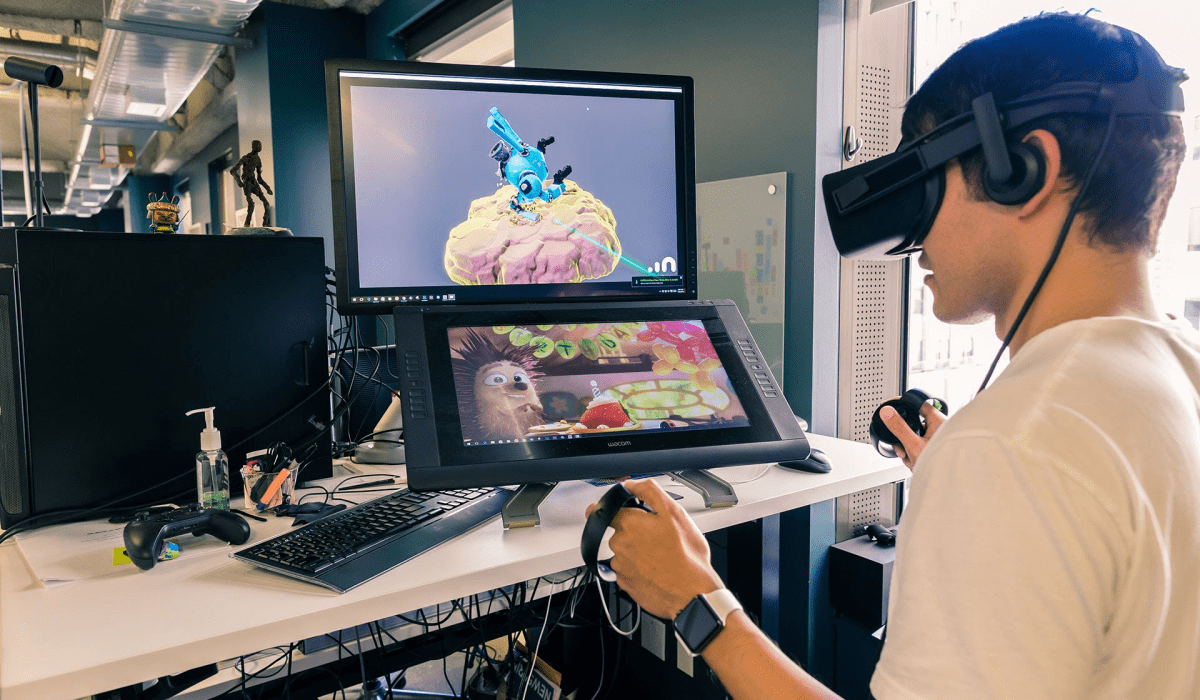
The video game development landscape is a constant battleground for innovation. One of the most exciting advancements is the integration of Artificial Intelligence (AI) for enemy behavior. Forget static targets – AI paves the way for cunning opponents who react and adapt to your tactics, transforming video game development and elevating the player experience.
The Rise of AI: Smarter Enemies, Deeper Engagement
Did you know a recent Game Developers Conference (GDC) study revealed that over 70% of game developers are actively exploring AI in their projects? This surge in interest reflects the immense potential of AI to revolutionize video game development, particularly in the realm of enemy behavior. Here’s why:
- From Predictable to Cunning: Say goodbye to enemies who blindly follow pre-programmed routines. AI allows enemies to analyze player actions and adapt accordingly. Imagine foes that flank you, learn from your strategies, and force you to constantly adjust your approach within your video game development project. This injects a layer of tension and keeps players engaged.
- A Spectrum of Enemy Behaviors: Unleash a wider range of enemy behaviors with AI. Imagine enemies exhibiting fear when injured, calling for reinforcements when outnumbered, or even strategizing and working together to take down the player. These dynamic behaviors add realism and unpredictability within your video game development project, keeping players on their toes.
- Enhanced Replayability: With AI-powered enemies, each encounter becomes fresh and unique. Players cannot rely on the same tactics repeatedly, as enemies constantly adapt and learn from past encounters. This significantly boosts the replayability of your video game development project, encouraging players to return for new challenges.
Unveiling the Tools: How AI Powers Dynamic Enemies
Several AI techniques are used in video game development to craft dynamic enemies:
- Machine Learning on the Move: These algorithms allow enemies to learn from player data, such as movement patterns and attack strategies. Imagine enemies that adjust their tactics based on how they’ve been defeated in the past within your video game development project.
- Branching Behavior Trees: These structures define enemy behavior based on conditions and priorities. This allows for more complex decision-making, enabling enemies to choose actions based on the situation unfolding within your video game development project.
- Neural Networks: Inspired by the Brain: Inspired by the human brain, neural networks can learn complex patterns from data. This opens doors for even more sophisticated AI applications in video game development, such as enemies that can predict player behavior and react accordingly.
The Developer’s Challenge: Balancing Power and Performance
While AI for dynamic enemies offers immense potential, there are practical considerations for video game developers:
- Performance Optimization is Key: Complex AI algorithms can strain a game’s performance. Careful implementation is crucial to ensure smooth gameplay within the technical constraints of your video game development project. Striking a balance between powerful AI and smooth performance is essential.
- Data Collection and Training: Machine Learning requires a significant amount of data for training. Gathering and managing this data can be a complex task for video game developers, especially for smaller studios.
- Finding the Right Balance: Challenge vs. Frustration: AI shouldn’t overpower the core gameplay experience. Finding the right balance between player control and AI-driven enemy behavior is key for a successful video game development project. The goal is to enhance the challenge, not make enemies feel cheap or unfair.
The Future of AI and Dynamic Enemies: A Glimpse Ahead
As AI technology continues to evolve, the possibilities for dynamic enemies in video games are limitless:
- Emotionally Intelligent Enemies: Imagine enemies that react emotionally to player actions, expressing fear, anger, or even empathy. This could create a deeper level of immersion within your video game development project, forging a more complex relationship between players and the characters they encounter.
- Evolving Enemy Factions: Imagine enemy factions that adapt and evolve over time based on their encounters with players. This could create a dynamic world where enemies become more sophisticated and pose a greater threat as the game progresses within your video game development project.
- AI-Powered Bosses: Imagine epic boss battles where the boss reacts and adapts to player strategies in real-time. This could create truly unique and challenging endgame experiences within your video game development project.
Conclusion: Embrace AI and Craft Unforgettable Encounters
By embracing AI in video game development, you can create enemies that are not just challenging, but also engaging and memorable. AI allows for a level of dynamism and unpredictability that simply isn’t possible with traditional scripting techniques. So, are you ready to take your video game development project to the next level and craft enemies that will truly test players’ skills and leave a lasting impression?







